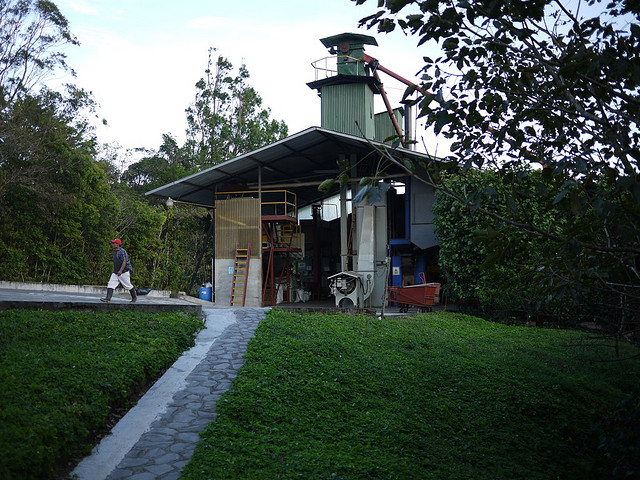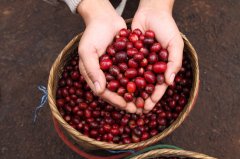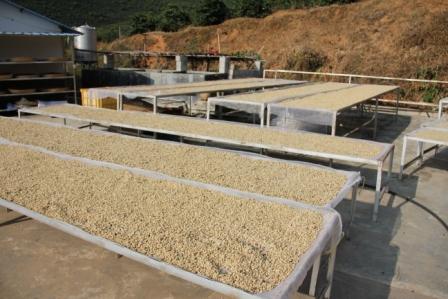Coffee growing at Incht Manor in Vivette Nan Fruit producing area, Pampa Camara, Bourbon, Guatemala
Guatemala is bordered by Mexico to the north and El Salvador and Honduras to the south. Guatemala produces about 3.5 million bags of coffee each year, and raw coffee beans account for 40 per cent of the country's total agricultural exports. This country, which mainly grows and exports coffee, has fertile soil suitable for coffee trees, suitable climate, abundant water resources and high altitude planting height. There are also many well-known producing areas in its territory, such as Antigua, Vivette Nanguo, Koban, Alcatel Nanguo, Attland, New Oriental, St. Marks and so on. Vivette Nango and Antigua are best known to coffee lovers.
"Huehuetenango" is translated as "Vivetta Nanguo" in Chinese. Whether in reading or in writing, the name sounds so good that it reminds me of the narino producing area of Colombia. A beautiful name, of course, must be matched with a beautiful flavor.
Vivette Nan Fruit is located in the highlands of northwestern Guatemala, growing at an altitude of 1800-2100 meters. It is the highest coffee-producing area in the country and is famous for producing high-quality beans. Due to the large number of rivers and lakes in Guatemala, the Vivette Nanguo region is rich in mountains and water resources, dry climate but abundant water resources, and complete water conservancy facilities in the region, coffee is mostly washed and processed. Vivette Nanguo coffee, rich taste, with a high mellow thickness, smoky taste is its most distinctive flavor.
Generally speaking, Arabica coffee grows at an altitude of about 2000 meters, while Robusta grows at an altitude of about 900m. If the altitude is too high, the coffee tree will frost because the temperature is too low, and even can not survive. And Vivette Nanguo coffee even if planted in the highlands of nearly 2000 meters above sea level, it is not easy to appear frost phenomenon, high but not cold growth environment has created high-quality extremely hard beans. This is entirely due to the warm, dry air blowing from the plains of Mexico, which protects the coffee trees from frost.
Like Costa Rica, El Salvador, Mexico, Honduras and other Central American countries, Guatemala's classification is based on altitude. Coffee produced at high altitudes is generally of higher quality than at lower altitudes, because the higher the altitude, the lower the temperature. At high elevations, the slower the coffee grows, the more beneficial it will be to the accumulation of good substances. That's why there is a way to classify quality by altitude. So what is the grading method based on altitude? Let's take Guatemala as an example. The higher the altitude, the higher the density of coffee beans and the higher the grade of raw coffee beans:
The highest grade is SHB (StrictlyHardBean) very hard beans, which are grown above 1350m above sea level.
Followed by HB (HardBean) hard beans, planted at 1200m~1400m above sea level.
There are also SH (SemiHardBean) slightly hard beans, which are planted at an altitude of 1200m.
Now that we are talking about the Vivette South Fruit producing area, we have to introduce the star manor here-ElInjerto, whose name comes from the unique fruit name "Incht" in the Vivette Nanguo region. There are quite a variety of coffee trees in the manor. Here, Bourbon, Pacamara, Marago Gippe and other varieties are planted. It has an excellent record in Guatemala's COE competition history: nine times in the list, six times in the first place, and won the national championship three times in a row from 2008 to 2010. It is admirable that a manor has such a record in the coffee industry. It can be said that Incht is the most respected manor in Guatemala.
Coffee cultivation at Incht Manor began in 1900. With a total area of 720 hectares, it maintains 470 hectares of primeval forest in order to maintain the natural and precious microclimate. To prevent the microclimate of the whole manor from being affected by excessive reclamation. The use of reasonable farming methods to protect soil nutrients, so that soil quality will not be gradually degraded by long-term cultivation, so as to maintain rich organic matter. In addition, the hardware facilities of the Incht treatment plant are complete, and the quality of the coffee is guaranteed in the later stage through orderly and scientific management. Incht is also very careful in the planting of coffee trees, whether in harvesting, pruning, or fertilization, coffee trees are carefully protected. The planting management of the whole manor has the advanced concept of symbiosis and win-win with ecology. As a result, Incht was certified by the Rainforest Alliance.
In the world of coffee, each producing country distinguishes multiple producing areas, and there will be many manors in different producing areas. The different varieties and processing methods of coffee planted in the manor will eventually lead to differences in the flavor of coffee. Even the microclimate of the producing area is skillfully affecting the quality of coffee. However, the charm of coffee lies in this. Every good cup of coffee condenses the hard work and wisdom of coffee people, and it is precisely because of all this that coffee is given a complex and changeable flavor.

Important Notice :
前街咖啡 FrontStreet Coffee has moved to new addredd:
FrontStreet Coffee Address: 315,Donghua East Road,GuangZhou
Tel:020 38364473
- Prev

Honduras is located in the tropical region of San Juan cidol low acid bourbon.
Because Honduras is located in the tropics, the annual temperature change in San Juan Theodore is more than that.
- Next

Elevated bed Solar treatment of Heirloom Coffee Raw beans in Ethiopia Cedar Mosida Masha Chiso producing area
The coffee flavor of Sidamo is very diverse, because of the different soil composition, regional microclimate and countless native coffee varieties, the coffee produced in each urban area has obvious differences and characteristics. Sidamo producing area (Sidama) is located in the south of Ethiopia. The industry here is dominated by agriculture, and the coffee growing area is located around the East African Great Rift Valley (GreatRiftValley).
Related
- Does Rose Summer choose Blue, Green or Red? Detailed explanation of Rose Summer Coffee plots and Classification in Panamanian Jade Manor
- What is the difference between the origin, producing area, processing plant, cooperative and manor of coffee beans?
- How fine does the espresso powder fit? how to grind the espresso?
- Sca coffee roasting degree color card coffee roasting degree 8 roasting color values what do you mean?
- The practice of lattes: how to make lattes at home
- Introduction to Indonesian Fine Coffee beans-- Java Coffee producing area of Indonesian Arabica Coffee
- How much will the flavor of light and medium roasted rose summer be expressed? What baking level is rose summer suitable for?
- Introduction to the characteristics of washing, sun-drying or wet-planing coffee commonly used in Mantenin, Indonesia
- Price characteristics of Arabica Coffee Bean Starbucks introduction to Manning Coffee Bean Taste producing area Variety Manor
- What is the authentic Yega flavor? What are the flavor characteristics of the really excellent Yejasuffi coffee beans?

